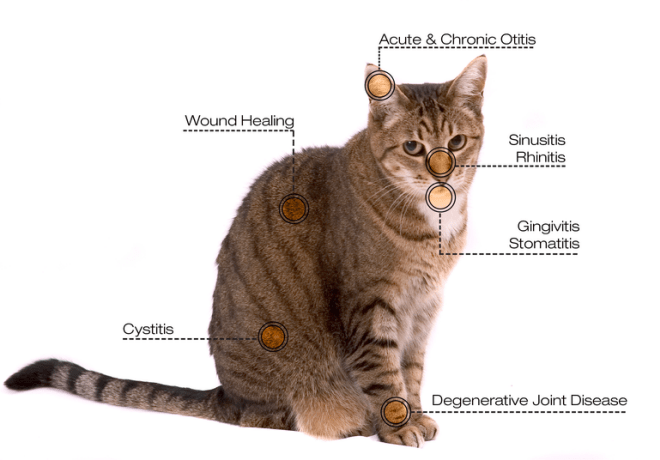Pet Therapy Laser For Your Best Veterinary Experience
Surgery and General Surgery
Surgical lasers have become a very important part of Veterinary medicine. The advent of the surgical laser has improved the treatment of many disease states previously treated with a scalpel or electrosurgical unit.
Dimed veterinary laser therapy equipment is designed for applications in minimally invasive surgery, open surgery, and bio-stimulation for small and large animal care. Emitting in the near-infra-red portion of the spectrum, it has unsurpassed absorption in water and hemoglobin, which allows controlled tissue ablation and enables a bloodless field for most surgical procedures. Unlike other lasers, Dimed pet therapy laser cuts and coagulates optically with negligible tissue damage, charring, or recession. Many procedures using Dimed veterinary laser machines are pain-free, minimizing or even eliminating the need for anesthesia. Laser surgery means less pain, blood loss, and swelling as well as a reduction in post-surgical infections.
- Acral Lick Granuloma Ablation
- Anal Sac Abcessation
- Castration
- Ceruminous Adenocarcinoma
- Chronic Ulcer Debridement and Sterilization
- Cranial Cruciate Ligament Rupture – Debridement
- Cutaneous Masses – Tags, Inclusion Cysts, Papillomas
- Declaw
- Deep Mass Removal
- Epibulbar Melanoma
- Fibrosarcoma
- Graft Bed Preparation – Infected Wounds
- Granulation Tissue Shaving
- Hemangiopericytoma
- Hemostasis
- Hepatic Carcinoma – Partial Hepatic Lobectomy
- Liposarcoma Resections
- Malignant Melanoma
- Mast Cell Tumors
- Perianal Fistulas
- Perianal Tumors
- Perianal Urethostomy Stricture Revisions
- Pericardectomy
- Rhabdomyxoma of Flank
- Squamous Cell Carcinoma
- Subtotal Prostatectomy
- Tendon Sheath Tumors
- Thyroidectomy
- Transitional Cell Carcinoma of the Bladder
- Traumatic Wound Debridement
- Tumor Bed Ablations
- Tumor/Mass Removal
- Urethral Prolapse Resections
- Urinary Bladder Polyps
Functional Benefits Of Diode Veterinary Surgical Laser For The Surgeon
1. Ease of Use:
With low space requirements due to its compact design, the Dimed veterinary laser machine is ideal for any setting not requiring special power or water as may be needed on some laser systems. The state-of-the-art high-resolution color touch-sensitive display provides a quick and easy interface to all system functions.
2. Higher Power and Flexibility:
Depending on the laser model and choices of 15, 20, 30, and 60 watts, the Dimed Lasers are ideal for surgery in both companion animals as well as in horses where higher energies are required.
3. Extraordinary Flexibility of This System Offered:
- Non-contact coagulation and vaporization
- Contact cutting
- Interstitial coagulation
- Equipped with an international-standard SMA connector
- Accommodates a variety of fiber sizes from 200, 400, and 600 microns
4. Cost Effective and Higher Efficiency:
Dimed pet therapy laser uses advanced diode technology that provides a longer operating life and easy maintenance.
5. Multiple Surgical Capabilities:
Laser surgery improves many surgical procedures by making them simpler and reducing risk. This enables surgeries that are not practical with conventional methods.
6. Enhanced Visibility of the Surgical Field:
The Dimed veterinary therapy laser seals capillaries and small blood vessels as it cuts, thereby dramatically reducing bleeding. This results in a much clearer and drier surgical site.
7. Increased Precision and Control:
The focal spot size of the beam may be adjusted down to a small fraction of a millimeter or expanded for much wider coverage. The Dimed veterinary laser may be set for rapid removal of relatively large tissue amounts, or adjusted to remove only one cell layer at a time.
8. Reduction of Surgery Time:
The hemostatic effect of the Dimed Laser and the improved visibility of the surgical field often reduce the duration of the surgery.
Laser Assisted Rehabilitation
Animal Rehabilitation works much like human rehabilitation. Using Laser Therapy, veterinarians are able to implement rehabilitation treatment plans to restore mobility, strengthen muscles and joints, and help animals heal faster post-operatively while focusing on reducing pain. Laser Therapy may begin prior to surgery, following an injury, or upon referral for a limb deformity. But it is most successful when laser therapy treatments are integrated and coordinated from the beginning, when the initial injury occurs, and prior to a surgery being performed. Maintenance laser therapy can be used post-rehabilitation to assist continued mobility, strength, and fitness
The power of the pet therapeutic laser matters in terms of the dose delivered, and the time needed to deliver the treatment dose. Power is a unit of time, and is expressed in watts (W) or milliwatts (mW). One watt is one Joule of energy delivered per second, and the laser dose is typically expressed as Joules/cm2 – the energy delivered over a surface area. The most commonly used therapeutic lasers in veterinary medicine are Class III lasers, which may deliver energy from 1mw to 500mw, and Class IV veterinary lasers, which deliver power at greater than 500mw.


- A lower-watt laser provides less energy delivery to deeper tissues so the time needed to deliver a treatment is longer. A lower-power laser is better suited for treating superficial structures because of the limited power density to drive photons into the deeper tissues.
- A higher-watt laser allows the treatment to be delivered over a shorter period and involves administering the laser energy with a sweeping motion over the affected area. This sweeping motion may provide more complete coverage of the treatment area and may cover surrounding areas that could be causing secondary or referred pain. Pulsing of the laser beam may provide less heating of tissues at the surface while allowing for an adequate level of energy to reach the deeper target tissues, but more research is needed to define the optimal approach to a pulsed laser beam.
Dimed High Power(Watts) Veterinary Therapy Lasers Typically Improved For Below Conditions:
- Arthritis (Degenerative Joint Disease)
- Back Pain (Intervertebral Disc Disease)
- Trauma (Skin, Muscle, Bone)
- Wounds (Trauma)
- Surgery (Incisions, Growth Removals, Bone Surgery)
- Inflammatory Conditions:
- Acute or chronic otitis (Ear problems)
- Anal Gland inflammation
- Hot Spots
- Lick Granulomas
- Idiopathic Cystitis – (Bladder Inflammation)
- Sinusitis, Rhinitis (Nasal problems)


